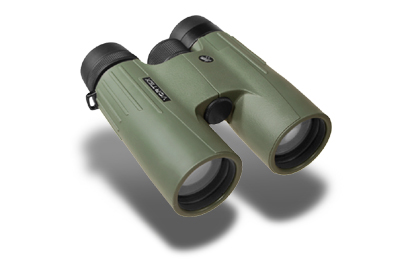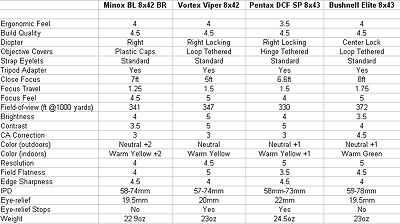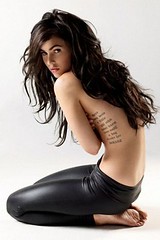
Recently, I conducted a side-by-side binocular comparison with the Vortex Viper against similarly featured models at various price points, all under $1,000.00. When conducting binocular tests, I don't like to include too many binoculars, so you may opine that some obvious favorites are missing from this review.
Though the Viper is available in three magnifications (8x42, 10x42 and 12x42), I compared only 8x models. All binoculars were tripod mounted against standard resolution charts at 50 feet with indoor lighting. I also brought the binoculars outside for distance, color and brightness tests at different times (including dusk) on an overcast day with good atmospheric conditions.
Binoculars used for this comparison/review:
My Score Card:

(click on image for larger version)
Ranking: 1 = poor, 2 = fair, 3 = good, 4 = above average, 5 = outstanding.
Ergonomics / Build Quality
All four binoculars felt very comfortable in my hands leaving only minor points to be critical over. The Pentax is slightly bulkier than the other three binoculars. All four are waterproof and nitrogen purged – build quality seems very high and suspect all would be dependable in the field. If pressed to rule one out on perceived build quality, the Minox would be the last of the four I would pick if going on a mountain hike or birding in a damp rainforest.
The Pentax and Viper both have a right-side locking diopter, while the Elite has a center diopter beneath the focus knob that locks. The Minox has a standard right side non-locking diopter ring. The Pentax has tethered objective lens covers attached at the hinge (I don't like those), but that's still better than the separate plastic covers that are easily lost (what the Minox comes with). The Elite and the Viper have looped tethered objective lens covers (my favorite) that are easy to cover and uncover. Each binocular has standard strap eyelets and are also threaded on the central hinge to connect to a standard binocular tripod adapter.
Focus Wheel / Travel
In testing the focus wheels I looked for comfort, focus travel/speed and smoothness. All four binoculars are between 1.25 and 1.75 turns from close-focus to infinity Minox: 1.25; Viper: 1.5; Pentax: 1.5; Elite: 1.75. All were similar in smoothness when turning the focus knob – none were stiff or had noticable play. The Viper and Elite were smoothest and the Pentax seemed to have only slightly more resistance.
Close Focus and Field of View
A super-close focus isn't critical for my applications, so even the Elite with an 8 foot close focus is satisfactory. The Pentax was 6.6 feet and the Minox has a 7 foot close focus. The Viper came in with the best close focus at 5 feet. At 347 feet @ 1,000 yards, the Viper's field of view is generous for its price range and beat the Pentax and the Minox. Naturally, the more expensive Elite topped out in this category with 372 feet @ 1,000 yards.
Brightness, Contrast and Color
The Viper was the clear winner on brightness – a discernible difference over the other three. The Pentax and Minox seemed about the same to my eye. The low mark for the Elite doesn't necessarily mean it's a poor low-light performer, it's just not quite as good as the others in the tests I conducted. I could not detect any negligible difference in contrast between the Pentax and the Viper. The Elite was a close runner-up with the Minox being about average.
The Bushnell Elite topped the other three in correcting chromatic aberration (purple/green color fringing) and I was unable to detect any significant difference between the other three binoculars. In outdoor lighting, whites seemed a little warm on the Pentax and Elite, but the Minox was the warmest. The Viper was the most color-neutral and pleasing to my eye of the four. In indoor lighting, as expected, all of the binoculars appeared to be a little warm but the Elite had more of a greenish tinge when looking at whites. The Minox remained the warmest of the four in indoor and outdoor lighting.
The Pentax and Elite were about even for resolution and ranked highest in my evaluation, but the Viper had a clear advantage over the other binoculars for field flatness. By field flatness, I mean the tendency of vertical objects (like a telephone pole) to remain a straight line when bringing it to the edge of the field. To be fair, the Elite has a larger field of view and I ranked it nearly as high as the Viper. The Pentax had noticeable field curvature among the four binoculars. I was unable to make a distinction on edge sharpness. Naturally, none of the binoculars in this review are going to match the edge sharpness of a Swarovski or Leica. I gave the Pentax and the Minox the highest score with the other two being very close behind it.
The Vortex Viper is about half the price of the Bushnell Elite, making it a strong contender in the mid-priced binocular race. The higher priced Pentax DCF SP is one of my favorite binoculars and the Viper definitely gives it a run for its money. I chose the Minox BL/BR in this review as a standard lightweight 8x42 mid-priced roof prism binocular. Because the Vortex Viper isn't much more expensive than the Minox, I think it's a clear winner in its price class for the quality of glass and optical performance.
Update: Award Winning Vortex Viper!

















